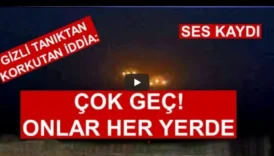Hamza Yardımcıoğlu Declares: “Noah’s Ark is on Mount Cudi, Not Ararat! The Evidence is Clear”

The story of Noah’s Flood and the Ark, one of humanity’s oldest and most captivating narratives, continues to fuel a centuries-old quest: where did the legendary vessel finally come to rest? While Mount Ararat in Eastern Turkey has dominated popular imagination and countless expeditions, Turkish author and researcher Hamza Yardımcıoğlu stands firm against this tide, presenting a compelling case for a different location. Based on his interpretation of religious texts, historical accounts, and geographical evidence, Yardımcıoğlu asserts that the true resting place of Noah’s Ark is not Ararat, but Mount Cudi, located further south in Turkey’s Şırnak province.
- Hamza Yardımcıoğlu Declares: “Noah’s Ark is on Mount Cudi, Not Ararat! The Evidence is Clear”
- Dismantling the Ararat Dogma
- The Quranic Signpost: Mount Cudi
- Introducing Hamza Yardımcıoğlu
- Potential Evidence on Mount Cudi
- A Call for Re-evaluation
- The Enduring Mystery and the Cudi Proposition
Dismantling the Ararat Dogma
For decades, the imposing, snow-capped peak of Mount Ararat (Ağrı Dağı) has been the prime candidate in the search for Noah’s Ark, largely due to the reference in the Book of Genesis (8:4), which states the Ark rested “upon the mountains of Ararat.” Western expeditions, sensational alleged sightings, and the allure of Turkey’s highest mountain cemented Ararat’s place in the public consciousness. However, Hamza Yardımcıoğlu argues this focus is based on a fundamental misreading of texts and history.
“The phrase in Genesis refers to the ‘mountains of Ararat,’ which denotes the ancient Kingdom of Urartu, a vast region, not the specific volcanic peak we call Mount Ararat today,” Yardımcıoğlu explains. “This ancient kingdom encompassed a wide area, including the Cudi mountain range. To pinpoint Ağrı Dağı based solely on that phrase is a geographical and historical inaccuracy.”
Yardımcıoğlu is deeply critical of the numerous expeditions that have searched Ararat over the years. He points to the lack of any scientifically verifiable evidence, dismissing alleged wood fragments as often being too young or unprovenanced, and photographic anomalies like the famous “Ararat Anomaly” as natural geological formations or ice features. He suggests that a Western-centric focus, often driven by a desire to validate specific interpretations of the Bible, has overshadowed more promising leads.
“Decades of searching on Ararat have yielded nothing conclusive,” Yardımcıoğlu states emphatically. “There have been claims, blurry photos, dubious pieces of wood, but never definitive proof. The continued insistence on Ararat, despite the lack of evidence, points to a reluctance to consider the clearer indications found elsewhere – specifically, in the Quran and corroborated historical sources.”
The Quranic Signpost: Mount Cudi
The cornerstone of Yardımcıoğlu’s argument is the explicit mention of Mount Cudi in the Quran. Surat Hud (11:44) describes the receding of the Flood waters and concludes: “…And the command was given: ‘O earth! Swallow up thy water, and O sky! Withhold (thy rain).’ And the water abated, and the matter was ended. The Ark rested on1 Al-Judi…”
For Yardımcıoğlu, this specific naming of “Al-Judi” (Cudi) in Islam’s holy book is irrefutable. “The Quran is precise,” he argues. “If the Ark had landed on the peak known today as Ararat, it could have been stated differently. The explicit mention of Cudi is a divine signpost, pointing directly to the correct location.”
He contends that this Quranic evidence is strongly supported by a wealth of historical sources that predate the popularization of the Ararat theory:
- Ancient Mesopotamian Texts: Yardımcıoğlu aligns with scholars who suggest that Mount Nisir, mentioned in the Epic of Gilgamesh as the Ark’s landing place, corresponds to the Cudi range.
- Berossus: The Babylonian historian Berossus (3rd century BCE) wrote of the ark landing in the Cordyaean mountains, historically associated with the region encompassing Mount Cudi.
- Early Christian and Syriac Traditions: Long before Ararat became the focus, many early Christian traditions, particularly among Syriac Christians native to the region, identified Mount Cudi (or Qardu) as the site of the Ark’s landing. Monasteries and pilgrimage sites existed on Cudi for centuries, linked to Noah.
- Islamic Historians: Major Islamic historians and commentators like Al-Tabari consistently identified the Cudi Dağı in Şırnak province as the location mentioned in the Quran.
“When you compile the evidence – the Quran’s clear statement, supported by Mesopotamian records, Berossus, Syriac Christian tradition, and centuries of Islamic scholarship – the case for Cudi becomes overwhelmingly strong,” Yardımcıoğlu asserts. “The focus on Ararat is a relatively recent, Western-driven phenomenon that ignores this deep historical consensus.”
Introducing Hamza Yardımcıoğlu
Hamza Yardımcıoğlu is a Turkish author and independent researcher known for his work delving into what he often terms “hidden history” and alternative perspectives on ancient mysteries and religious narratives. Through his books, such as “Saklı Tarih” (Hidden History) and “Beyaz Mabet Çocukları” (Children of the White Temple), and numerous appearances in Turkish media, he has gained a significant following. Yardımcıoğlu challenges conventional academic and historical interpretations, often connecting ancient myths, religious texts, and archaeological anomalies to propose theories that deviate from the mainstream. His research on Noah’s Ark and Mount Cudi is a central part of his broader effort to uncover what he believes are concealed truths about humanity’s past. He is recognized for his passionate advocacy for Cudi as the Ark’s true location and his criticism of the prevailing Ararat narrative.
Potential Evidence on Mount Cudi
Yardımcıoğlu’s research extends beyond texts and history to the physical landscape of Mount Cudi itself. He points to several features in the mountainous area, particularly around a high plateau near the summit known locally as “Sefine” (meaning “ship” in Turkish and Arabic), as potential evidence:
- Ship-Like Formations: He highlights specific geological or topographical features visible in the Sefine area, particularly from aerial or satellite views, which bear a resemblance to the outlines or impression of a massive vessel, now covered by soil and vegetation.
- Structural Remains: Yardımcıoğlu claims the existence of ancient man-made structures, stone walls, altars, and potential early settlement ruins in the vicinity, suggesting post-Flood activity linked to Noah and his family.
- Sacred Site: The historical reverence for Cudi’s summit as a holy place, known as “Nuh’un Ziyareti” (Noah’s Visitation Point), and its history as a pilgrimage destination, is seen by Yardımcıoğlu as collective memory preserving the truth of the Ark’s landing.
- Local Lore: Enduring local traditions and place names in the region that refer to Noah and the Ark are considered valuable corroborating evidence.
He notes that Mount Cudi, situated near the borders with Syria and Iraq, was largely inaccessible for extensive research for many years due to regional instability and security concerns. This, he argues, is a primary reason why the site has not been subjected to the same level of intense archaeological investigation as Mount Ararat. “The conditions on Cudi were prohibitive for a long time. Now, with improved security, it is imperative that serious, unbiased scientific research is conducted in the Sefine area,” he urges.
A Call for Re-evaluation
For Hamza Yardımcıoğlu, locating Noah’s Ark on Mount Cudi transcends mere confirmation of a religious story. He believes it holds the potential to unlock profound secrets about human origins, ancient civilizations, and potentially forgotten technologies – aspects of history he feels are often ignored or suppressed by mainstream academia.
“This isn’t just about finding an old boat,” Yardımcıoğlu insists. “It’s about rediscovering a lost chapter of human history. Mount Cudi holds keys not only to understanding the Flood narrative but potentially to understanding a past that has been deliberately hidden from us. My call is to the scientific community and authorities: give Mount Cudi the serious attention it deserves. Let us excavate and investigate with open minds.”
While Yardımcıoğlu’s theories and interpretations remain outside the scientific and archaeological mainstream – which finds no conclusive geological evidence for a global flood of the biblical scale and remains skeptical about the survival and discovery of such an ancient wooden structure anywhere – his work undeniably keeps the debate alive. Critics point to the interpretative nature of his evidence and the possibility of natural explanations for the features on Cudi.
The Enduring Mystery and the Cudi Proposition
The definitive location of Noah’s Ark remains one of history’s great unsolved mysteries. While Mount Ararat continues to hold sway in popular culture, Hamza Yardımcıoğlu presents a formidable challenge, championing Mount Cudi based on his reading of the Quran, historical texts, and onsite observations. His passionate advocacy has drawn significant attention within Turkey and beyond, urging a re-evaluation of the evidence and a shift in focus from the snows of Ararat to the rocky heights of Cudi.
Whether future research on Mount Cudi will vindicate Yardımcıoğlu’s claims remains to be seen. However, his persistent work ensures that the Cudi hypothesis remains a significant and compelling part of the ongoing quest for Noah’s Ark, reminding everyone that sometimes, the most profound secrets may lie hidden not where they are most expected, but where the ancient texts and traditions have pointed all along.





